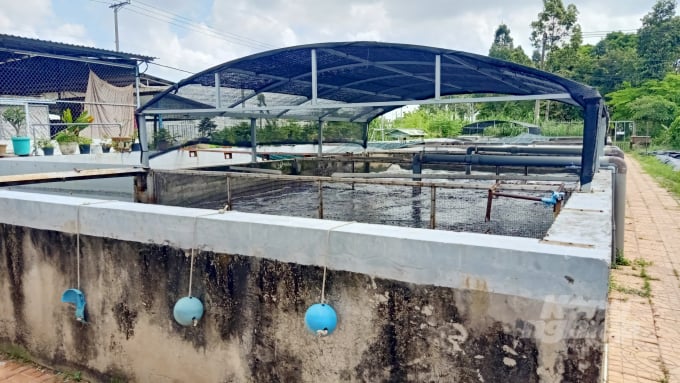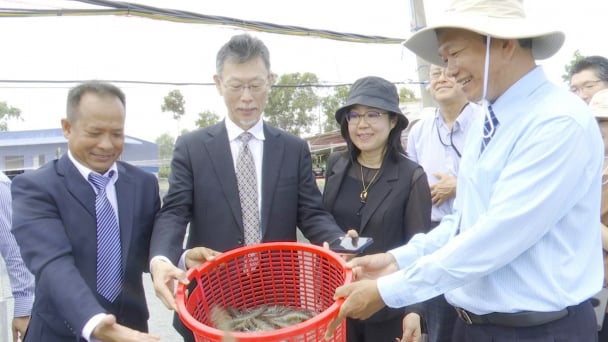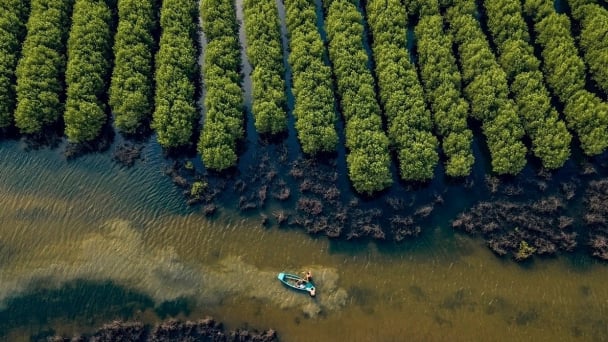June 15, 2025 | 13:19 GMT +7
June 15, 2025 | 13:19 GMT +7
Hotline: 0913.378.918
June 15, 2025 | 13:19 GMT +7
Hotline: 0913.378.918

The parental catfish grow well in the salinity of 10/1,000 in the recirculation tank of the Fishery Faculty, Can Tho University. Photo: Kim Anh.
Under the influence of climate change, many localities in the Mekong Delta are facing saline intrusion. To cope with the situation, various agricultural production models and research projects have been formed to help farmers adapt and develop well in drought conditions.
In 2017, the Fishery Faculty of Can Tho University in cooperation with the University of Liège and the University of Namur (Belgium) developed a project themed "Towards a sustainable pangasius breeding, a selection approach" (PANGAGEN Project ).
One of the PANGAGEN Project's goals is to develop a line of salt-tolerant catfish, aiming to develop pangasius breeding and provide high-quality salt-tolerant fingerlings for pangasius farming, especially in areas with poor quality and saltwater intrusion in the Mekong Delta. The project has been implemented for the period from 2017 to 2022.
According to Assoc. Prof. Dr. Duong Thuy Yen, Deputy Head of the Department of Freshwater Aquaculture Technology, Fishery Faculty, and also the scientific secretary of the project, the idea of pangasius domestication in the saltwater environment was initiated before 2017.
Studies by the Faculty of Fisheries and practical experience of pangasius farming households show that the fish has the ability to withstand brackish water. In particular, brackish water penetrating deep into the field in 2016 had motivated scientists' determination to implement the project.
“We gathered breeds of 10 females and 10 males from each of 3 farms in provinces of Vinh Long and An Giang, and Can Tho city, for cross-breeding and created about 900 fish families called Generation 1 (G1).
G1 was grown in freshwater ponds until the fish reached 4 - 5 grams in weight. The research team conducted domestication of pangasius in water with a salinity degree of 10/1000 parts in a recirculating tank system.
After a year, the G1 pangasius continued to be raised in water with a salinity degree of 5/1000 parts until they became parents", Assoc. Prof. Dr. Yen said about the pangasius domestication process.
In the water recirculation tank system, the salinity degree was controlled and maintained stably at 10/1000. This had helped train the catfish to get used to the saltwater environment creating convenience for the research team in assessing the adaptability of pangasius in saltwater conditions.

The recirculation system helps control salinity and accurately assess the adaptability of pangasius during the research process. Photo: Kim Anh.
During one year, pangasius went through 3 selections, the team selected 50% of the largest fishes in the school to keep and took another random group to compare with the selected ones.
Evaluating the results, Dr. Yen said: "When pangasius was one year old, the fish size reached about 1.4 kilograms, the random unselected fish only reached about 780 grams, much smaller than the selected fish."
Dr. Yen added that when raising the fish from fingerlings to the commercial stage, at salinity levels of 5/1000 and 10/1000, selected breeds can grow better than freshwater ones. They can still suffer salinity at 15/1000 but the growth will be affected. At a salinity of 20/1000, the fish will fiercely be impacted.
“Thus, with the salinity environment at 5/1000 and 10/1000, the salt-tolerant catfishes can grow well. If they are grown in freshwater, their survival and growth rate is equal to or even better than that of fish grown in freshwater," according to the results given by the research team.
However, according to Dr. Yen, the project has faced its biggest difficulty due to the impact of the Covid-19 pandemic in the past 2 years. The transfer of breeds to localities for practical farming in ponds of local households in saltwater areas has not been implemented yet hindering the implementation process of the research team.
In 2022, the team plans to grow pangasius more in households to produce and evaluate the effectiveness of the project.
At the same time, theywill continue to select the next generations, with the expectation that the fish can grow at higher salinity, providing sustainable and comprehensive solutions for catfish aquaculture.
Translated by Linh Nguyen
![Turning wind and rain into action: [4] Bringing climate bulletins to remote and isolated areas](https://t.ex-cdn.com/nongnghiepmoitruong.vn/608w/files/linhnhp/2025/06/14/1152-z6704423696987_15fd32ffc26d590d204d520c9dac6786-nongnghiep-151141.jpg)
(VAN) The Vietnam Agriculture and Nature Newspaper interviewed Mr. Vu Thai Truong, Acting Head of Climate Change and Environment at UNDP Vietnam, to gain deeper insight into how climate bulletins are delivered to farmers.

(VAN) In Tien Giang, a high-tech shrimp farm has developed a distinctive energy-saving farming model that has yielded promising results.
![Turning wind and rain into action: [3] 300.000 farmers benefit from agro-climatic bulletins](https://t.ex-cdn.com/nongnghiepmoitruong.vn/608w/files/news/2025/06/12/e5a48259d6a262fc3bb3-nongnghiep-125122.jpg)
(VAN) The agro-climatic bulletin has become a valuable tool for farmers in the Mekong Delta. After more than five years of implementation, the initiative is gradually being expanded nationwide.
![Turning wind and rain into action: [2] Providing forecasts to the people](https://t.ex-cdn.com/nongnghiepmoitruong.vn/608w/files/news/2025/06/12/e5a48259d6a262fc3bb3-nongnghiep-103927.jpg)
(VAN) In addition to improving the quality of hydrometeorological forecasts, putting forecast bulletins into practical use is crucial for production and disaster prevention.

(VAN) Blue carbon is receiving attention for its rapid absorption capacity and vast potential. It represents a promising nature-based solution to respond to climate change.
/2025/06/11/3507-1-161904_583.jpg)
(VAN) Seagrass beds and coral reefs serve as 'cradles' that nurture life in the ocean depths, creating rich aquatic resources in Vietnamese waters.
![Turning wind and rain into action: [1] Forecasting for farmers](https://t.ex-cdn.com/nongnghiepmoitruong.vn/608w/files/news/2025/06/11/e5a48259d6a262fc3bb3-nongnghiep-111919.jpg)
(VAN) Weather is no longer just a matter of fate. Forecasts have now become an essential companion for farmers in every crop season.